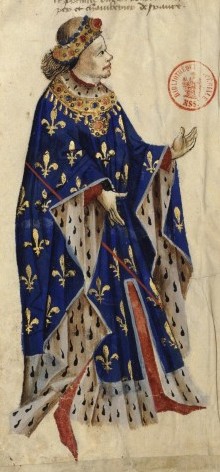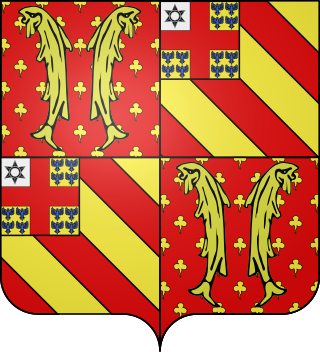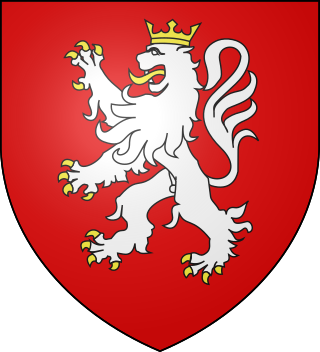
The House of Bourbon is a dynasty that originated in the Kingdom of France as a branch of the Capetian dynasty, the royal House of France. Bourbon kings first ruled France and Navarre in the 16th century. A branch descended from the French Bourbons came to rule Spain in the 18th century and is the current Spanish royal family. Further branches, descended from the Spanish Bourbons, held thrones in Naples, Sicily, and Parma. Today, Spain and Luxembourg have monarchs of the House of Bourbon. The royal Bourbons originated in 1272, when Robert, the youngest son of King Louis IX of France, married the heiress of the lordship of Bourbon. The house continued for three centuries as a cadet branch, serving as nobles under the direct Capetian and Valois kings.

The House of Montmorency was one of the oldest and most distinguished noble families in France.

Louis I, called the Lame was a French prince du sang, Count of Clermont-en-Beauvaisis and La Marche and the first Duke of Bourbon, as well as briefly the titular King of Thessalonica from 1320 to 1321.

The Constable of France was lieutenant to the King of France, the first of the original five Great Officers of the Crown and the commander-in-chief of the Royal Army. He was, at least on paper, the highest-ranking member of the French nobility.

James I of Bourbon, was a French prince du sang, and the son of Louis I, Duke of Bourbon and Mary of Avesnes. He was Count of Ponthieu from 1351 to 1360, and Count of La Marche from 1341 to his death.

Antoine Juchereau Duchesnay was the Seigneur of Beauport, Saint-Denis, Fossambault, Gaudarville, and Saint-Roch-des-Aulnaies. He fought with the Troupes de Marine and after the British Conquest of New France joined the British Army, defending Fort Saint-Jean where he was captured and imprisoned by the Americans in 1775. He represented Buckingham County in the 1st Parliament of Lower Canada and was afterwards appointed a member of the Executive Council of Lower Canada.

Robert IV of Dreux (1241–1282), Count of Dreux, Braine and Montfort-l'Amaury, was the son of John I of Dreux and Marie of Bourbon.
Charlotte de Laval, Dame de Châtillon, was a French noblewoman from one of the most powerful families in Brittany. She was the first wife of Gaspard de Coligny, Seigneur de Châtillon, Admiral of France and a prominent Huguenot leader during the French Wars of Religion. She was the mother of Louise de Coligny, the fourth wife of William the Silent, Prince of Orange. The present British Royal Family directly descends from her.

Guy I of Clermont-Nesle was a Marshal of France, Seigneur (Lord) of Offemont jure uxoris, and possibly of Ailly, Maulette and Breteuil. He might have been a Seigneur of Nesle also, or used the title "Sire of Nesle" due to his family. Difficulties about the seigneurie of Breteuil are present, and the status of Ailly and Maulette in relation to Breteuil.
Bouchard II, known as Bouchard le Barbu was a French aristocrat, holding the position of Lord of Montmorency.

Jeanne de Clisson (1300–1359), also known as Jeanne de Belleville and the Lioness of Brittany, was a French/Breton noblewoman who became a privateer to avenge her husband after he was executed for treason by King Philip VI of France. She crossed the English Channel targeting French ships and often slaughtering their crew. It was her practice to leave at least one sailor alive to carry her message of vengeance.
The Counts of Dammartin were the rulers of the county of Dammartin, based in the current commune of Dammartin-en-Goële as early as the 10th century. Located at the central plain of France, the county controlled the roads of Paris to Soissons and Laon. It seems that this county was initially held by Constance, the wife of Manasses Calvus, the first Count. The name Dammartin-en-Goële comes from Domnus Martinus, the Latin name of St. Martin of Tours, who evangelized the region of Goële in the fourth century. A small town in the district of Meaux in the Department of Seine-et-Marne, ancient village of Region of Île-de-France, it appears to go back to the earliest times; Dammartin-en-Goële, also called Velly, was in 1031 one of the most significant places in France.
Pierre II de Villiers (1365–1399) was a medieval French noble. He resided in the Castle of L'Isle-Adam until he died in 1399. He was lord of L'Isle-Adam until the death of his father, and he later became the Chamberlain of King Charles VI.

Édouard I de Beaujeu a Marshal of France, Lord of Beaujeu and Montpensier was a 14th-century French noble.
Charles II François Frédéric de Montmorency, was the eighth Duke of Piney-Luxembourg and the second Duke of Montmorency (Beaufort), prince of Aigremont and of Tingry, count of Bouteville, of Lassé, of Dangu and of Luxe, peer of France, marshal of France in 1757 and the governor of Normandy in 1762. He was the son of Charles I Francois Frederic de Montmorency-Luxembourg and grandson of Marshal François-Henri de Montmorency, duc de Luxembourg. His mother was Marie-Gilonne Gillier de Clérembault, daughter of René. In 1750 he married the wealthy widow Madeleine Angélique Neufville de Villeroy.

Olivier IV de Clisson (1300–1343), was a Breton Marche Lord and knight who became embroiled in the intrigue of Vannes and was subsequently executed by the King of France for perceived treason. He was the husband of Jeanne de Clisson who eventually became known as the Lioness of Brittany.

Jean II de Montmorency, held the office of Grand Chamberlain of France. He was the eldest son of Jacques de Montmorency and Lady Philippine de Melun of Croisilles and Courrières, daughter of Hugues de Melun d'Epinoy.












